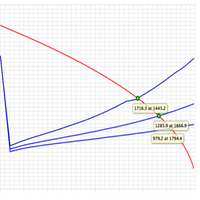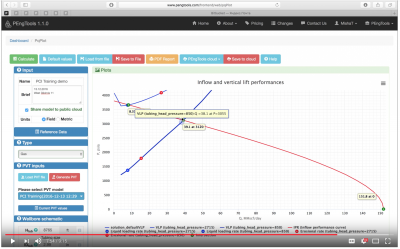Difference between revisions of "Category: PQplot"
(→Typical applications) |
|||
| (47 intermediate revisions by the same user not shown) | |||
| Line 1: | Line 1: | ||
__TOC__ | __TOC__ | ||
| − | == | + | == Well Nodal Analysis Software == |
| − | [[File:PQPLOT_i.png|thumb|300px|link=https://www.pengtools.com/pqPlot| PQplot]] | + | [[File:PQPLOT_i.png|thumb|300px|link=https://www.pengtools.com/pqPlot| PQplot nodal analysis software]] |
| − | [[:Category:PQplot | PQplot]] is the core ''' | + | [[:Category:PQplot | PQplot software]] is the core '''petroleum engineering''' engine of the [[:Category: Pengtools | pengtools]]. |
| − | [[:Category:PQplot | PQplot]] calculates inflow performance relationship [[IPR]] and vertical lift performance [[VLP]] curves for oil and gas wells. | + | [[:Category:PQplot | PQplot software]] calculates inflow performance relationship [[IPR]] and vertical lift performance [[VLP]] curves for oil and gas wells. |
| − | [[:Category:PQplot | PQplot]] is available online at [https://www.pengtools.com www.pengtools.com] | + | [[:Category:PQplot | PQplot software]] is available online at [https://www.pengtools.com www.pengtools.com]. |
== Typical applications == | == Typical applications == | ||
| − | * Estimation of flow | + | * Calculating the [[Well Nodal Analysis]] <ref name= JM8025/> model of the well |
| − | * | + | * Matching the [[Well Nodal Analysis]] model to the well test data |
| − | * | + | * Calculating and exporting the [[IPR]] curves: [[Vogel's IPR]], [[Composite IPR]] |
| + | * Calculating and exporting the [[VLP]] tables to Excel or reservoir simulator | ||
| + | * Estimation of well's [[Production Potential]] and absolute open flow (AOF) | ||
| + | * Tubing sizing | ||
| + | * Gas lift design | ||
* Selection of the operating wellhead pressures | * Selection of the operating wellhead pressures | ||
* Estimation of the effects of reservoir pressure depletion | * Estimation of the effects of reservoir pressure depletion | ||
| − | * | + | * Sensitivity studies |
== Main features == | == Main features == | ||
| + | * Multiphase flow correlations | ||
* Plot of Inflow performance curve [[IPR]] and Vertical lift performance curve [[VLP]] | * Plot of Inflow performance curve [[IPR]] and Vertical lift performance curve [[VLP]] | ||
* Rate and pressure at intersection point | * Rate and pressure at intersection point | ||
| − | * | + | * Tubing, annular and tubing+annular flow types |
| − | * | + | * "Default values" button resets input values to the default values |
| − | * | + | * Switch between Metric and Field units |
| − | * | + | * Save/load models to the files and to the user’s cloud |
| + | * Share models to the public cloud or by using model’s link | ||
| + | * Export pdf report containing input parameters, calculated values and plots of the PQplot | ||
| + | * Continue your work from where you stopped: last saved model will be automatically opened | ||
| + | * Download the chart as an image or data and print (upper-right corner chart’s button) | ||
| + | * Export results table to Excel or other application | ||
| − | == | + | ==Demo== |
| + | The demo is a copy of a training seminar. This video demonstrates basic functionality of the [[:Category:PVT | PVT Software]] and [[:Category:PQplot | PQplot software]]. It is shown how to create the well nodal analysis model, run sensitivity, save the model. | ||
| − | * | + | [[File:PQplot_demo.png|400px|link=https://youtu.be/oioheTV45tU | Watch on youtube]] |
| − | * | + | |
| − | * | + | In this demo we are solving the homework where it was asked to: |
| − | * | + | * Calculate the flowing bottomhole pressure. |
| − | * | + | * Construct [[VLP]] curve |
| − | * | + | * Construct [[IPR]] and calculate AOF |
| + | * Calculate current production efficiency (production/AOF) | ||
| + | * What is the production potential and what actions do you propose to close the performance gap? | ||
| + | * What will be production increment from the proposed actions? | ||
| + | |||
| + | [https://www.pengtools.com/pvtCalculator?paramsToken=b4bd505e0a17a75adb14f0989f89c502 PVT model at www.pengtools.com]<BR/> | ||
| + | [https://www.pengtools.com/pqPlot?paramsToken=9fba6c3fa125c5e6d8aa101e5cf9b52c PQplot model at www.pengtools.com] | ||
== Correlations == | == Correlations == | ||
| Line 67: | Line 84: | ||
</td></tr> | </td></tr> | ||
<tr><td> | <tr><td> | ||
| − | Oil well | + | Oil well [[IPR]] |
</td><td> | </td><td> | ||
| − | Composite IPR | + | [[Composite IPR]] – [[Vogel's IPR]] based equations taking into account water |
</td><td> | </td><td> | ||
Kermit E. Brown "The Technology of Artificial Lift | Kermit E. Brown "The Technology of Artificial Lift | ||
| Line 76: | Line 93: | ||
</td></tr> | </td></tr> | ||
<tr><td> | <tr><td> | ||
| − | Gas well | + | Gas well [[IPR]] – backpressure equation |
</td><td> | </td><td> | ||
Rawlins and Schellhardt | Rawlins and Schellhardt | ||
| Line 83: | Line 100: | ||
</td></tr> | </td></tr> | ||
<tr><td> | <tr><td> | ||
| − | Gas well | + | Gas well [[IPR]] – pseudo-pressure equation using Jd and kh values |
</td><td> | </td><td> | ||
Real-gas pseudopressure equation | Real-gas pseudopressure equation | ||
| Line 106: | Line 123: | ||
| − | PVT correlations are the same as in [[PVT | + | PVT correlations are the same as in [[:Category:PVT|PVT software]]. |
| + | |||
| + | == References == | ||
| + | <references> | ||
| + | <ref name=JM8025>{{cite journal | ||
| + | |last1=Mach|first1=Joe | ||
| + | |last2=Proano|first2=Eduardo | ||
| + | |last3=E. Brown|first3=Kermit | ||
| + | |title=A Nodal Approach For Applying Systems Analysis To The Flowing And Artificial Lift Oil Or Gas Well | ||
| + | |publisher=Society of Petroleum Engineers | ||
| + | |number=SPE-8025-MS | ||
| + | |date=1979 | ||
| + | |url=https://www.onepetro.org/general/SPE-8025-MS | ||
| + | |url-access=registration | ||
| + | }}</ref> | ||
| + | |||
| + | </references> | ||
[[Category:pengtools]] | [[Category:pengtools]] | ||
| + | |||
| + | {{#seo: | ||
| + | |title=Well Nodal Analysis Software | ||
| + | |titlemode= replace | ||
| + | |keywords=nodal analysis, nodal analysis software, tubing, reservoir, fluids flow, sensitivity, gas flow, petroleum engineering | ||
| + | |description=PQplot petroleum engineering software calculates inflow performance relationship and vertical lift performance curves for oil and gas flow for well nodal analysis. | ||
| + | }} | ||
Latest revision as of 10:10, 10 May 2024
Contents
Well Nodal Analysis Software
PQplot software is the core petroleum engineering engine of the pengtools.
PQplot software calculates inflow performance relationship IPR and vertical lift performance VLP curves for oil and gas wells.
PQplot software is available online at www.pengtools.com.
Typical applications
- Calculating the Well Nodal Analysis [1] model of the well
- Matching the Well Nodal Analysis model to the well test data
- Calculating and exporting the IPR curves: Vogel's IPR, Composite IPR
- Calculating and exporting the VLP tables to Excel or reservoir simulator
- Estimation of well's Production Potential and absolute open flow (AOF)
- Tubing sizing
- Gas lift design
- Selection of the operating wellhead pressures
- Estimation of the effects of reservoir pressure depletion
- Sensitivity studies
Main features
- Multiphase flow correlations
- Plot of Inflow performance curve IPR and Vertical lift performance curve VLP
- Rate and pressure at intersection point
- Tubing, annular and tubing+annular flow types
- "Default values" button resets input values to the default values
- Switch between Metric and Field units
- Save/load models to the files and to the user’s cloud
- Share models to the public cloud or by using model’s link
- Export pdf report containing input parameters, calculated values and plots of the PQplot
- Continue your work from where you stopped: last saved model will be automatically opened
- Download the chart as an image or data and print (upper-right corner chart’s button)
- Export results table to Excel or other application
Demo
The demo is a copy of a training seminar. This video demonstrates basic functionality of the PVT Software and PQplot software. It is shown how to create the well nodal analysis model, run sensitivity, save the model.
In this demo we are solving the homework where it was asked to:
- Calculate the flowing bottomhole pressure.
- Construct VLP curve
- Construct IPR and calculate AOF
- Calculate current production efficiency (production/AOF)
- What is the production potential and what actions do you propose to close the performance gap?
- What will be production increment from the proposed actions?
PVT model at www.pengtools.com
PQplot model at www.pengtools.com
Correlations
| Type of problem | Correlation | Reference |
|---|---|---|
|
Oil well VLP |
Hagedorn, A. R., & Brown, K. E. (1965). Experimental study of pressure gradients occurring during continuous two-phase flow in small-diameter vertical conduits. Journal of Petroleum Technology, 17(04), 475-484. | |
|
Gas well VLP |
Gray, H. E. (1974). Vertical flow correlation in gas wells. User manual for API14B, subsurface controlled safety valve sizing computer program. | |
|
Dry gas VLP |
Cullender, M.H. and Smith, R.V. 1956. Practical Solution of Gas-Flow Equations for Wells and Pipelines with Large Temperature Gradients. Trans., AIME 207: 281. | |
|
Oil well IPR |
Composite IPR – Vogel's IPR based equations taking into account water |
Kermit E. Brown "The Technology of Artificial Lift Methods" Vol. 4 Production Optimization of Oil and Gas Wells by Nodal System Analysis, p. 30, section 2.227.1 |
|
Gas well IPR – backpressure equation |
Rawlins and Schellhardt |
Rawlins, E.L. and Schellhardt, M.A. 1935. Backpressure Data on Natural Gas Wells and Their Application to Production Practices, Vol. 7. Monograph Series, USBM. |
|
Gas well IPR – pseudo-pressure equation using Jd and kh values |
Real-gas pseudopressure equation |
See for example: Ahmed, T., & McKinney, P. (2011). Advanced reservoir engineering. Gulf Professional Publishing. |
|
Turner |
Turner, R. G., Hubbard, M. G., and Dukler, A. E. (1969) “Analysis and Prediction of Minimum Flow Rate for the Continuous Removal of Liquids from Gas Wells,” Journal of Petroleum Technology, Nov. 1969. pp. 1475–1482. | |
|
Guidelines from API RP14E |
Mokhatab S, Poe WA, Speight JG (2006) "Handbook of Natural Gas Transmission and Processing", Section 11.6 - Design Considerations on sales gas pipelines, subsection 11.6.1 - Line Sizing Criteria, Elsevier, 2006. |
PVT correlations are the same as in PVT software.
References
- ↑ Mach, Joe; Proano, Eduardo; E. Brown, Kermit (1979). "A Nodal Approach For Applying Systems Analysis To The Flowing And Artificial Lift Oil Or Gas Well"
 (SPE-8025-MS). Society of Petroleum Engineers.
(SPE-8025-MS). Society of Petroleum Engineers.
Pages in category "PQplot"
The following 13 pages are in this category, out of 13 total.


